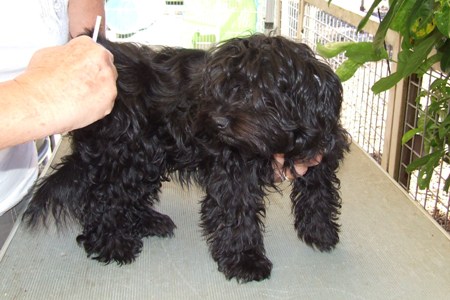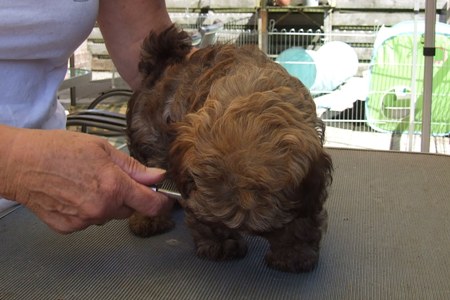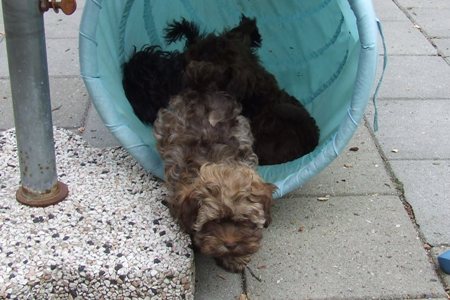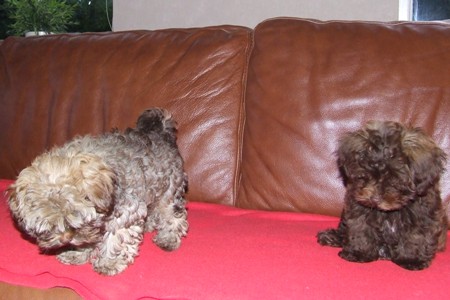|
|
We
like to tell you what we know about the
Bolonka
and why we fell in love with the breed. In short, what you can and can't
expect of the breed.
|
|
|
|
Character, Behavior and Appearance
Appearance:
They are a small compact built dog, which is a
bit longer then high.
Height for males and females is
between 20 and 26 cm.
Weight between 3 and 4 kg.
Character
and
Behavior:
The difference between the Bolonka
and a lot of other smaller dogs is their character as they are
very easy going with humans and other animals. They adapt very
easily and are very social.
Like most small dogs, they can reach
a high age.
Coat:
The topcoat is long, silky and wavy, the undercoat is thick. They need to be combed and
brushed every week.
All colors are allowded, except white
and mottled (a small spot on the chest and white toes are
allowed)
Teeth:
Preferred is a complete scissor bite,
a pincer bite and reversed scissor bite is allowed
up
|
|
|
|
 |
 |
|
|
|
Male or female ?
There is not much difference between the male and female. I The
females are absolutely not more friendly or easier than the
males.
The males are usually more "even" tempered, because they don't
have problems with hormones. They may show some macho behavior
with a big mouth and somewhat rash and impulsive behavior, but
can also be affectionate and ready to please. In appearance they
are often more imposing with a longer and fuller coat.
The female is somewhat fickle, because of hormonal fluctuations.
On average, she will be in heat every nine months, at which time
you will notice a difference in her behavior. For example,
before going into heat she may be listless, spiritless and
cranky. After her heat, she may experience a false pregnancy
up
|
|
|
|
|
|
|
|
|
The Puppy!
A puppy is of course adorable, lovable and impressionable. To
raise a puppy properly, is very time consuming. They need
patience, experience and consistent behavior from you. If it is
your first dog, you will surely want some help. That is why, we
advise everyone that takes a puppy, to enroll in puppy
kindergarten or an obedience class. The first year there is so
much to learn for the puppy and owner, that even the most well
intentioned new owner can make mistakes.
When you have a puppy, you have a "baby" dog in your home, that
needs a lot of attention and rest (particularly in a home with
children). The pup will need to eat 3-4 times a day, need to be
housebroken, and won't be able to stay home alone for long
periods of time. An owner working full time for the first few
months, is very difficult for a puppy. Even working part time,
is not advised for the first few weeks, unless you have someone
else at home caring for the dog.
up
|
|
|
|
 |
 |
|
|
|
History
The history of the breed is not quit
clear, but one of the stories is the following:
The ancestors of the Tsvetnaya
Bolonka migrated to the Russian Empire with the army of Napoleon
Bonaparte and were now as the French Bolonka. Bolonka means
lapdog in Russian and Tsvetnaya Bolonka means coloured lapdog.
When the
army of Napoleon withdrew, some of this dogs remained in the
Russian Empire and they are the founders of the breed what now
is known as the "Russkaya Tsvetnaya Bolonka" we don’t know of
this story is true, but it likely that the Russian royalty, like
all other royal ladies,
had
a small lapdog to entertain them.
After the
Second World War a lot of people were interested in new breeds
and also in the small companion dogs and they developed them out
of already existing breeds like Bichon Frisé, Maltese, Shih Tzu
and the Yorkshire Terrier.
In 1951 they
made the first combinations, they wanted to breed a small dog
between the 20 and 24 cm. and in 1958 they were already
successful with this.
But it was difficult to breed,
because Stalin did not approve to breed “useless” dogs.
When Nikita
Khrushchev came in charge (1958-1964) the restrictions were
lifted and they could start again with breeding small companion
dogs.
Because most people lived in small
apartments, small dogs like Russian toy Terrier and the Bolonka
became very popular.
The Russkaya
Tsvetnaya Bolonka was created from several toy breeds like Lhasa
Apso, Miniature Poodle, Shih Tzu, Bolognese, Pekinees ans
several small lapdogs which were already there.
In 1962 in
the breed became the name “Tsvetnaya Bolonka” and in 1966 it was
recognized by the ministry of Agriculture. The interest of the
breed are represented by the RKF (Russian Kynological
Federation) this organisation is similar as the FCI.
During the
eighties of last century the breed became more popular and the
national breed club was founded in 1999.
Today the
Bolonka is very popular in Russia, but also in the rest of the
world people start to love them.
The breed is
not FCI recognized and that means that the Dutch Kennel Club (
Raad v.Beheer) does not recognize the breed as well, in contrast
to the countries around us. They accept the breed and register
them with the remark on the pedigree “not FCI recognized”
Only if Russia asks for recognition
by the FCI ( and the FCI accepts ) we can register them in the
Dutch pedigree records.
That is why we are a member of the "Europäischen
Rassehund Verein" and we will breed in co-operation and according to
the rules of this Breed Club and our puppies will get a pedigree
of this Breed Club
up |
|



